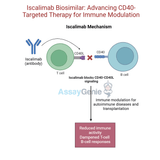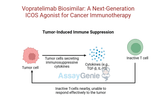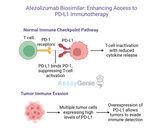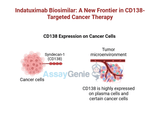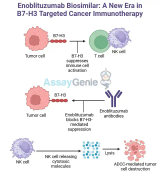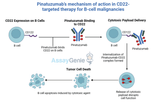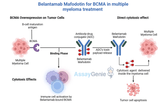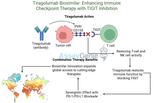Blog
Iscalimab: Advancing Research in Autoimmune Diseases and Transplantation
What You Need to Know About IscalimabWhat is Iscalimab?Iscalimab (CFZ533) is a monoclonal antibody targeting CD40, a key protein involved in immune system regulation.What is the mechanism of action for Iscalimab?Iscalimab blocks the CD40-CD40L pathway, preventing the activation of T cells and B cells, which are central to autoimmune responses and transplant rejection.What are the clinical applications of Iscalimab?Iscalimab is under investigation for treating autoimmune diseases like Sjögren's syndrome, lupus nephritis, and for improving outcomes in organ transplantation.1.) Understanding IscalimabIscalimab (CFZ533) is an innovative monoclonal antibody developed by Novartis to
…
15th Jan 2025
Vopratelimab: Unlocking the Potential of ICOS in Cancer Research
What You Need to Know About VopratelimabWhat is Vopratelimab?Vopratelimab is an experimental monoclonal antibody that targets the Inducible T-cell CO-Stimulator (ICOS) protein, playing a pivotal role in enhancing immune system activity against cancer.What is the mechanism of action for Vopratelimab?Vopratelimab activates ICOS on T-cells, boosting their proliferation and effector functions, which are crucial for mounting an effective anti-tumor immune response.What are the clinical applications of Vopratelimab?Emerging studies suggest that Vopratelimab holds promise in cancer immunotherapy, particularly for solid tumors like non-small cell lung cancer (NSCLC) and head and neck s
…
15th Jan 2025
Brentuximab: Unveiling the Role of Anti-CD30 in Cancer Research
Key Facts About BrentuximabWhat is Brentuximab?Brentuximab is a monoclonal antibody targeting CD30, commonly used in the treatment of Hodgkin lymphoma and systemic anaplastic large cell lymphoma.What is the mechanism of action for Brentuximab?Brentuximab vedotin works by delivering a cytotoxic agent to CD30-positive cells, inducing cell death through a targeted mechanism.What are the clinical applications of Brentuximab?Brentuximab is primarily utilized in managing Hodgkin lymphoma, systemic ALCL, and other CD30-positive malignancies. It has also been studied in combination therapies for enhanced efficacy.1.) Understanding BrentuximabBrentuximab vedotin is a revolutionary antib
…
15th Jan 2025
Gemtuzumab: Advancing CD33-Targeted Therapies in AML Research
Key Facts About GemtuzumabWhat is Gemtuzumab?Gemtuzumab is an antibody-drug conjugate (ADC) targeting CD33, a protein expressed on the surface of myeloid cells. It is widely recognized for its role in treating acute myeloid leukemia (AML).How does Gemtuzumab work?Gemtuzumab binds to CD33-positive cells and delivers a cytotoxic agent, ozogamicin, to induce cell death specifically in AML cells, sparing healthy tissue.What is the approval history of Gemtuzumab Ozogamicin?Initially approved by the FDA in 2000, Gemtuzumab ozogamicin (Mylotarg) faced a withdrawal in 2010. However, it was reapproved in 2017 after new data affirmed its efficacy and safety.1.) Understanding GemtuzumabGe
…
15th Jan 2025
Atezolizumab: Unveiling the Role of Anti-PD-L1 in Cancer Research
Quick Facts About AtezolizumabWhat is Atezolizumab?Atezolizumab is an anti-PD-L1 monoclonal antibody used in immunotherapy to treat various cancers by enhancing the immune system's ability to attack tumors.What is the mechanism of action for Atezolizumab?Atezolizumab blocks the interaction between PD-L1 and PD-1, restoring T-cell activity and promoting anti-tumor immunity.What are the clinical applications of Atezolizumab?It is approved for cancers such as non-small cell lung cancer (NSCLC), triple-negative breast cancer (TNBC), and urothelial carcinoma, among others.1.) Understanding AtezolizumabAtezolizumab, marketed as Tecentriq, is a pioneering PD-L1 checkpoint inhibitor de
…
15th Jan 2025
Cobolimab: Unveiling TIM-3’s Role in Cancer Immunotherapy
Quick Facts About CobolimabWhat is Cobolimab?Cobolimab is a monoclonal antibody that targets TIM-3, a checkpoint protein involved in immune regulation, especially in cancer and autoimmune diseases.How does Cobolimab work?By inhibiting TIM-3, Cobolimab reactivates T-cells, boosting the immune system’s ability to identify and destroy cancer cells.What is Cobolimab’s significance in GSK’s research?As part of GSK’s immuno-oncology pipeline, Cobolimab is being investigated for its potential in combination therapies to improve cancer treatment outcomes.1.) Understanding CobolimabCobolimab is a novel monoclonal antibody developed to enhance cancer immunotherapy by targeting T-cell imm
…
15th Jan 2025
Indatuximab: Advancing CD138-Targeted Therapy in Cancer Research
What You Need to Know About IndatuximabWhat is Indatuximab?Indatuximab ravtansine is an experimental monoclonal antibody-drug conjugate (ADC) that targets CD138, a protein highly expressed on the surface of certain cancer cells, including multiple myeloma and some solid tumors.What is the mechanism of action for Indatuximab?Indatuximab ravtansine delivers a cytotoxic agent directly to cancer cells by binding to CD138, ensuring selective killing of malignant cells while sparing healthy tissues.What are the clinical applications of Indatuximab?Indatuximab ravtansine is being explored in clinical trials for its potential to treat relapsed and refractory multiple myeloma as well as
…
14th Jan 2025
Enoblituzumab: Unveiling the Role of Anti-B7-H3 in Cancer Research
Key Facts About EnoblituzumabWhat is Enoblituzumab?Enoblituzumab is a monoclonal antibody targeting the B7-H3 protein, which is expressed on the surface of various cancer cells, including those in prostate cancer, sarcoma, and ovarian cancer.What is the mechanism of action for Enoblituzumab?Enoblituzumab works by binding to the B7-H3 protein on tumor cells, blocking its immune evasion mechanisms and enhancing immune system recognition and destruction of the cancer cells.What are the clinical applications of Enoblituzumab?Enoblituzumab is primarily being studied in clinical trials for its potential to treat cancers such as prostate cancer, sarcoma, and ovarian cancer. Emerging s
…
14th Jan 2025
Targeting IL-10R: Enhancing Immune Activation in Cancer
Introduction to IL-10R and Immune Suppression in CancerThe interleukin-10 receptor (IL-10R) is a key player in regulating immune responses, particularly in suppressing inflammation and maintaining immune tolerance. IL-10R is activated by its ligand, interleukin-10 (IL-10), an anti-inflammatory cytokine that is critical in controlling excessive immune activation and preventing tissue damage during infection or inflammation. However, in the context of cancer, IL-10 signaling can be exploited by tumor cells to suppress immune responses, particularly by inhibiting the activity of T cells and dendritic cells, creating a microenvironment conducive to tumor growth.Targeting IL-10R with
…
12th Dec 2024
Pinatuzumab: Advancing Cancer Research and Therapeutics
Quick Facts About PinatuzumabWhat is Pinatuzumab?Pinatuzumab is an antibody-drug conjugate (ADC) designed to target CD22, a protein highly expressed on B-cell malignancies, including non-Hodgkin lymphoma (NHL).What is the mechanism of action for Pinatuzumab?It delivers cytotoxic agents directly to cancer cells by binding to CD22, resulting in targeted cell death while sparing healthy tissues.What are the clinical applications of Pinatuzumab?Pinatuzumab has been explored in clinical trials for treating B-cell lymphomas and other hematologic malignancies.Is Pinatuzumab still in use?While specific trials have concluded, Pinatuzumab’s foundational research continues to inform ADC d
…
12th Dec 2024
Belantamab: A Game-Changer in Multiple Myeloma Therapy
Quick Facts About BelantamabWhat is Belantamab?Belantamab Mafodotin is a cutting-edge antibody-drug conjugate (ADC) designed for the treatment of relapsed or refractory multiple myeloma.How does Belantamab work?It targets B-cell maturation antigen (BCMA) on multiple myeloma cells, delivering a potent cytotoxic agent to destroy cancerous cells effectively.What are the side effects of Belantamab?Keratopathy (eye toxicity) is the most notable adverse effect, requiring regular ophthalmic monitoring during treatment.Is Belantamab approved?Yes, Belantamab Mafodotin received accelerated approval from the FDA for patients with limited treatment options for multiple myeloma.1.) Understa
…
12th Dec 2024
Vibostolimab: Mechanism, Clinical Applications, and Research Potential in Oncology
Key Facts About VibostolimabWhat is Vibostolimab?Vibostolimab is an anti-TIGIT monoclonal antibody developed by Merck, targeting immune checkpoint pathways to enhance anti-tumor immunity.What is the mechanism of action for Vibostolimab?Vibostolimab inhibits TIGIT, a receptor that suppresses T-cell activity, promoting a robust immune response against cancer cells.What are the clinical applications of Vibostolimab?It is investigated for various cancers, including melanoma and non-small cell lung cancer (NSCLC), often in combination with pembrolizumab.Is Vibostolimab safe?Studies have demonstrated a manageable safety profile, with side effects similar to other immune checkpoint in
…
12th Dec 2024
Tiragolumab: Unlocking New Horizons in Cancer Immunotherapy
Quick Facts About TiragolumabWhat is Tiragolumab?Tiragolumab is an anti-TIGIT monoclonal antibody developed to enhance immune responses against cancer cells. It is currently under investigation for its potential in treating various cancersWhat is the mechanism of action for Tiragolumab?Tiragolumab blocks TIGIT, a receptor on immune cells that inhibits anti-tumor activity, restoring the immune system's ability to attack cancer cells.What cancers does Tiragolumab target? Tiragolumab is being studied in non-small cell lung cancer (NSCLC), small cell lung cancer (SCLC), and other solid tumors, often in combination with atezolizumab.What cancers does Tiragolumab target? Pr
…
12th Dec 2024
Tesnatilimab: Unveiling the Potential of Anti-CD47 in Cancer Research
Quick Facts About TesnatilimabWhat is Tesnatilimab?Tesnatilimab is an anti-CD47 monoclonal antibody designed to block the "don’t eat me" signal used by cancer cells to evade immune responses.What is the mechanism of action for Tesnatilimab?Tesnatilimab binds to the CD47 receptor on cancer cells, enhancing their phagocytosis by macrophages and other immune cells.What are the clinical applications of Tesnatilimab?It is being explored for its efficacy in treating various cancers, including hematologic malignancies and solid tumors.Is Tesnatilimab safe?Studies highlight its potential with a manageable safety profile, though some patients may experience mild-to-moderate immune-relat
…
10th Dec 2024
Etigilimab: Unveiling the Role of Anti-TIGIT in Cancer Research
Key Facts About EtigilimabWhat is Etigilimab?Etigilimab is an anti-TIGIT monoclonal antibody being studied for its potential role in cancer immunotherapy.What role does Etigilimab play in targeting TIGIT?Etigilimab inhibits TIGIT, a receptor that suppresses T-cell activity, enhancing the immune system's ability to combat tumors.What are the clinical applications of Etigilimab?Etigilimab is being explored in combination therapies for treating various cancers, leveraging its immune-boosting capabilities.1.) Understanding EtigilimabEtigilimab, also known by its research name MGA271, is a monoclonal antibody that targets TIGIT (T-cell immunoreceptor with Ig and ITIM domains). TIGIT
…
10th Dec 2024
Varlilumab: Unlocking CD27’s Potential in Cancer Research
What You Need to Know About VarlilumabWhat is Varlilumab?Varlilumab is a monoclonal antibody targeting CD27, a receptor on T-cells that plays a critical role in immune modulation.What is the mechanism of action for Varlilumab?Varlilumab enhances immune responses by activating CD27 signaling, promoting T-cell proliferation, and regulating immune suppression in cancer.What are the clinical applications of Varlilumab?Varlilumab has been studied in combination therapies, particularly with immune checkpoint inhibitors like nivolumab, for cancers such as melanoma and glioblastoma.1.) Understanding VarlilumabVarlilumab (CDX-1127) is a human monoclonal antibody developed by Celldex The
…
5th Dec 2024
Biosimilar: Expanding Access to Monoclonal Antibody-Based Therapies
1. What is a Biosimilar? A biosimilar is a biologic medical product that is highly similar to an already-approved reference biologic. While minor differences in clinically inactive components may exist, biosimilars match the reference product in terms of safety, efficacy, and quality. HDBS0016 represents one such advancement, offering a cost-effective alternative for biologic therapies. 2. Key Features of HDBS0016 Mechanism of ActionBiosimilar HDBS0016 mimics the mechanism of its reference biologic, targeting specific pathways or antigens depending on its indication. These include:Immune Checkpoint Inhibition: Enhancing T-cell activity by blocking inhibitory recep
…
5th Dec 2024
CB6 Biosimilar: Targeting SARS-CoV-2 with Cost-Effective Monoclonal Antibody Therapy
CB6, also known as Etesevimab, is a monoclonal antibody that targets the receptor-binding domain (RBD) of the SARS-CoV-2 spike protein. It neutralizes the virus by preventing it from binding to the angiotensin-converting enzyme 2 (ACE2) receptor on human cells. CB6 has been studied in combination with other antibodies, such as Bamlanivimab, for treating mild to moderate COVID-19 and preventing disease progression. The biosimilar HDBS0011 replicates CB6’s efficacy and safety while providing a cost-effective option for broader global access.This article explores the mechanism of action, clinical applications, and potential benefits of HDBS0011 in addressing the COVID-19 pandemic.1
…
4th Dec 2024
Vorsetuzumab: Advancing Cancer Research with CD70 Targeting
What You Need to Know About VorsetuzumabWhat is Vorsetuzumab?Vorsetuzumab is a monoclonal antibody targeting CD70, a protein found in various cancers. It shows promise for advancing cancer immunotherapy due to its tumor-specific activity.What is Vorsetuzumab mafodotin?Vorsetuzumab mafodotin is an antibody-drug conjugate combining vorsetuzumab with a cytotoxic agent. This combination delivers targeted therapy, killing CD70-positive cancer cells.Why is Vorsetuzumab significant?Its high specificity for cancer cells and potential to enhance immune response make it a key focus in emerging oncology research.1.) Understanding VorsetuzumabVorsetuzumab is a targeted therapeutic age
…
27th Nov 2024
Talacotuzumab: Exploring CD123-Targeting Therapies in AML and MDS Research
Key Facts About TalacotuzumabWhat is Talacotuzumab?Talacotuzumab is a monoclonal antibody designed to target CD123, a protein commonly found on the surface of certain blood cancer cells.How does Talacotuzumab work?It binds to CD123, recruiting the body’s immune cells to destroy cancer cells, making it a targeted and innovative approach in cancer therapy.What are Talacotuzumab’s potential uses?Talacotuzumab has been studied for treating acute myeloid leukemia (AML) and myelodysplastic syndromes (MDS), offering hope for patients with these challenging conditions.1.) Understanding TalacotuzumabTalacotuzumab is a humanized monoclonal antibody developed to target CD123, a key marker
…
27th Nov 2024
Magrolimab: Unveiling the Role of Anti-CD47 in Cancer Research and Beyond
What You Need to Know About MagrolimabWhat is Magrolimab?Magrolimab is an anti-CD47 monoclonal antibody that targets the "don't eat me" signal on cancer cells, promoting their destruction by the immune system.Is Magrolimab safe?Magrolimab has shown a manageable safety profile in clinical trials, though side effects such as anemia and infusion reactions have been reported.What is the mechanism of action for Magrolimab?Magrolimab works by blocking CD47, a protein that helps cancer cells evade immune attack, thereby enabling macrophages to target and eliminate these cells.1.) Understanding MagrolimabMagrolimab is a groundbreaking therapeutic antibody developed to target CD47, a pr
…
27th Nov 2024
Elotuzumab: Revolutionizing Multiple Myeloma Treatment and Research Applications
Quick Facts About ElotuzumabWhat is Elotuzumab?Elotuzumab is a monoclonal antibody designed to enhance the immune system's ability to detect and destroy multiple myeloma cells. It targets the SLAMF7 protein, which is present on both myeloma and immune natural killer (NK) cells.How does Elotuzumab work?Elotuzumab activates NK cells by binding to SLAMF7, boosting their ability to attack cancer cells. It also directly marks myeloma cells for immune system destruction, making it a dual-action therapy.What is Elotuzumab used for?Primarily, Elotuzumab is used in combination therapies for relapsed or refractory multiple myeloma. These include pairings with drugs like lenalidomide, pom
…
26th Nov 2024
Pembrolizumab: Unveiling Its Mechanism and Research Applications with Biosimilars
Key Facts: PembrolizumabIs Pembrolizumab Safe?Pembrolizumab is widely recognized as safe for most patients, with side effects ranging from mild to severe. Commonly reported side effects include fatigue, rash, and immune-related complications such as colitis or pneumonitis.What is the Mechanism of Action for Pembrolizumab?Pembrolizumab functions by inhibiting the PD-1 pathway, a mechanism that tumors often exploit to evade immune detection. By blocking this pathway, Pembrolizumab enhances the immune system’s ability to identify and destroy cancer cells.Does Pembrolizumab Lower IgG4 Levels?Research has shown that Pembrolizumab can reduce IgG4 levels, which may influence immune mo
…
26th Nov 2024
Daratumumab: Advancing Research in Multiple Myeloma and Beyond
Key Facts About DaratumumabWhat is Daratumumab?Daratumumab is a monoclonal antibody that targets CD38, a protein highly expressed on the surface of multiple myeloma cells.How does Daratumumab work?It binds to CD38, triggering immune-mediated destruction of cancer cells through mechanisms like complement-dependent cytotoxicity and antibody-dependent cellular cytotoxicity.What are the clinical applications of Daratumumab?Daratumumab is primarily used in the treatment of multiple myeloma, both as a monotherapy and in combination with other therapies. Research is also exploring its potential in other hematologic cancers.1.) Understanding DaratumumabDaratumumab is a groundbreaking t
…
26th Nov 2024

